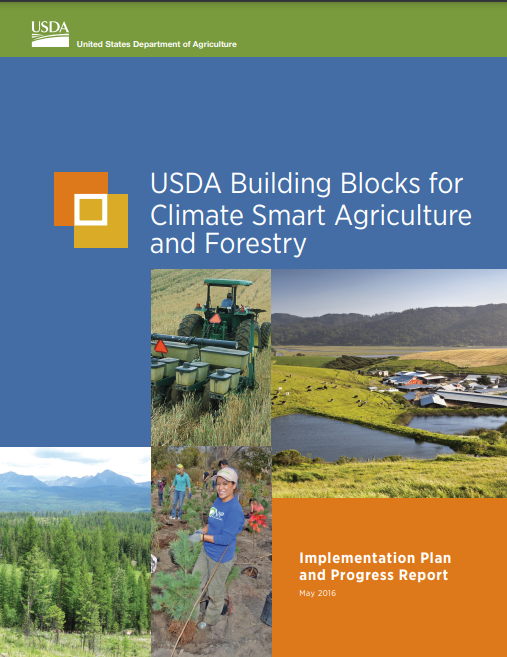Article /
USDA Building Blocks for Climate Smart Agriculture and Forestry: Implementation Plan and Progress Report

Introduction
This resource was submitted by the Climate Risk Institute for use by the CanAdapt Climate Change Adaptation Community of Practice.
This article is an abridged version of the original text, which can be downloaded from the right-hand column. Please access the original text for more detail, research purposes, full references, or to quote text.
On April 23, 2015, Secretary of Agriculture Tom Vilsack announced the U.S. Department of Agriculture’s (USDA) Building Blocks for Climate Smart Agriculture and Forestry. This plan is designed to help farmers, ranchers, forestland owners, and rural communities respond to climate change and consists of the following 10 “building blocks,” which span a range of technologies and practices to reduce greenhouse gas (GHG) emissions, increase carbon storage, and generate clean renewable energy:
Soil Health • Nitrogen Stewardship • Livestock Partnerships • Conservation of Sensitive Lands • Grazing and Pasture Lands • Private Forest Growth and Retention • Stewardship of Federal Forests • Promotion of Wood Products • Urban Forests • Energy Generation and Efficiency
- USDA has a long history of cooperative conservation and partnerships with farmers, ranchers, and forestland owners. The principles that have guided USDA’s cooperative conservation efforts also apply to each of these building blocks, and actions taken through this initiative will be:
- Voluntary and incentive-based: Farmers, ranchers, and forestland owners are stewards of the land. USDA has a track record of successful conservation though voluntary programs designed to provide technical assistance for resource management. These efforts fit within USDA’s approach of cooperative conservation.
- Focused on multiple economic and environmental benefits: To be successful, the proposed actions should provide economic and environmental benefits through efficiency improvements, co-benefits, improved yields, or reduced risks.
- Designed to meet the needs of producers: This strategy is designed for working farms, ranches, forests, and production systems. USDA will encourage actions that enhance productivity and improve efficiency.
- Cooperative and focused on building partnerships: USDA will seek out opportunities to leverage efforts by industry, farm groups, conservation organizations, municipalities, public and private investment products, Tribes, and States.
- Measured to evaluate progress: USDA is committed to establishing consistent quantitative goals and objectives for each building block and will track and report on progress. USDA will continue to use internationally recognized measures and will enhance the accuracy and precision of these metrics.
Through this comprehensive set of voluntary programs and initiatives, USDA expects to reduce net emissions and enhance carbon sequestration by more than 120 million metric tons of carbon dioxide equivalent (MMTCO2 e) per year by 2025. This reduction is equivalent of taking 25 million cars off the road or offsetting the emissions produced by powering nearly 11 million homes per year.
The building blocks are significant not only within the United States, but also internationally. In December 2015, more than 180 countries agreed to a new framework to reduce global GHG emissions and enhance GHG sinks. The Paris Agreement, adopted under the United Nations Framework Convention on Climate Change, builds on the U.S.’s commitment to reduce GHG emissions by 26 to 28 percent below 2005 levels by 2025. By developing these building blocks, USDA and its partners have demonstrated that agriculture and forests can play a significant role in helping the U.S. meet its commitment. In turn, the U.S. is modeling practices and strategies that can be applied by nations worldwide to address emissions from the land sector while also meeting the world’s needs for food, fiber, and energy.
This document provides an update on the building blocks framework since the April 2015 announcement. In particular, it:
- Outlines the goals for each building block, including estimated GHG reductions.
- Highlights actions that USDA has taken over the last year to help farmers, ranchers, and forestland owners respond to climate change.
- Provides implementation plans for each of the building blocks. Each implementation plan includes:
– A description of the programs and authorities that can be used to encourage adoption of technologies and conservation practices that help reduce GHG emissions;
– Opportunities for partnerships with other organizations, including industry groups; nongovernmental organizations; private companies; and other governmental agencies at the Federal, State, Tribal, and local levels; and
– Actions that USDA plans to take over the next 3 years to lay the foundation for achieving the building block goals.
- Summarizes next steps under the building blocks framework.
The building blocks are a set of actions to help farmers, ranchers, forestland owners, and rural communities reduce GHG emissions and increase carbon sequestration. These actions are an important piece of USDA’s broader effort to help agricultural, forestry, and rural communities respond to a changing climate. Other components of USDA’s strategy to address climate change include:
- Supporting community resiliency to climate change by developing climate change adaptation plans, establishing Regional Climate Hubs, and supporting Cooperative Extension;
- Updating and implementing its Climate Change Science Plan to develop science-based knowledge and strategies to manage the risks, challenges, and opportunities of climate change; reduce GHG emissions; and enhance carbon sequestration;
- Contributing to the Inventory of U.S. Greenhouse Gas Emissions and Sinks, which tracks annual U.S. GHG emissions and removals, including in the agriculture and forest sectors; and
- Continuing to enhance USDA’s tracking of its accomplishments under the building blocks, including GHG-related metrics.
Since the announcement of these building blocks, USDA and its partners have taken action to reduce GHG emissions and increase carbon sequestration from agriculture, forests, and rural areas. Through its Environmental Quality Incentives Program (EQIP), the Natural Resources Conservation Service (NRCS) will, in fiscal year (FY) 2016, invest approximately $300 million in practices that have climate change benefits, including a targeted allocation of $72.3 million specifically for practices that advance the building block goals. This funding is in addition to the more than $1.4 billion that NRCS has invested since 2009 in funding for EQIP practices that have climate-related benefits. The Rural Development’s Rural Business-Cooperative Service (RBS) awarded $12.5 million in grants and loans to support the installation of 17 anaerobic digesters and biogas systems in eight States as part of the Rural Energy for America Program (REAP). In partnership with the Softwood Lumber Board and the Binational Softwood Lumber Council, USDA announced the winners of the U.S. Tall Wood Building Prize Competition. The two winning development teams were granted a combined $3 million in funding to support the development of tall wood demonstration projects in New York and Portland, Oregon. These are only three of the numerous actions that USDA and its partners have taken over the last year; a detailed list can be found starting on p. 7.
To build on these accomplishments, the building blocks will remain an adaptable framework that will be revisited as new programs, research, technology, and partnerships expand opportunities to further reduce GHG emissions and enhance carbon sequestration. As this update shows, USDA is confident that the agricultural and forestry communities can continue to play an important role in reducing GHG emissions and increasing carbon storage in the Nation’s forests and soils.
